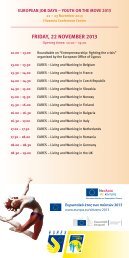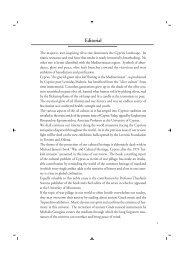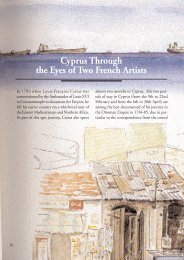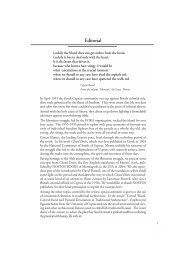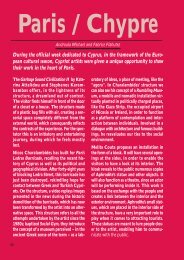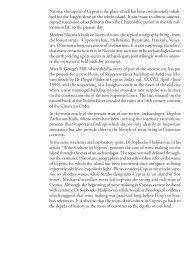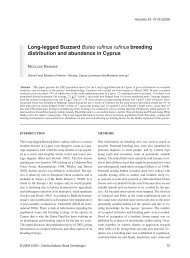Cyprus
Cyprus
Cyprus
Create successful ePaper yourself
Turn your PDF publications into a flip-book with our unique Google optimized e-Paper software.
An Island of Prospectors and Farmers<br />
Early and Middle Bronze Age, 2300-1600 BC<br />
Beginning in about 2400 BC, prospectors<br />
from Anatolia explored the island for copper.<br />
The discovery of rich deposits drew many<br />
communities from the Anatolian coast to settle<br />
on <strong>Cyprus</strong>. These migrants brought with<br />
them new ways of building houses, cooking,<br />
spinning, and weaving. They also brought<br />
cattle and the ox-drawn plow, creating an<br />
agricultural revolution. Plows opened up<br />
new terrain for farming, leading to a boom<br />
in food production and a rapid increase in<br />
population.<br />
The newcomers spread across the island, settling<br />
in the copper-rich foothills of the Troodos<br />
Mountains and living harmoniously with<br />
the local indigenous people. Over time, the<br />
communities merged to produce a rich and<br />
unique Bronze Age culture, characterized<br />
by local varieties of everyday pottery and an<br />
array of more elaborate vessels, models and<br />
figurines.<br />
In the Early Bronze Age, the use of metal<br />
became more widespread in <strong>Cyprus</strong>. By<br />
Ceramic<br />
double-necked<br />
jug (Early<br />
Bronze Age, ca.<br />
2100-2000 BC),<br />
excavated at<br />
Pyrgos<br />
26<br />
about 2400-2300 BC, copper was being cast<br />
into standard shapes, such as axe heads, presumably<br />
for the purpose of trade.<br />
As the trading of copper became more essential<br />
to the economy of the island, an extensive<br />
communication network developed<br />
between villages. Gradually, <strong>Cyprus</strong> began<br />
to export the metal and the island quickly<br />
became known to its neighbors for its rich<br />
copper resources.<br />
<strong>Cyprus</strong> Opens to the World<br />
Late Bronze Age, 1600-1050 BC<br />
The Late Bronze Age was a period of great<br />
prosperity. Across the eastern Mediterranean,<br />
trade networks linked Egypt, the Hittite<br />
Empire of central Anatolia, the Ugarit kingdom<br />
of coastal Syria, and the Mycenaeans<br />
of southern Greece in a vast interconnected<br />
economy. <strong>Cyprus</strong>, which documents of the<br />
time refer to as Alashiya, occupied a central<br />
place as a major supplier of copper.<br />
Stone casting mould (Early Bronze Age,<br />
ca. 2300-2100 BC), excavated at Marki<br />
During the Late Bronze Age the island<br />
became the apple of discord between the<br />
Hittite Empire and the Egyptian Pharaohs.<br />
However, it was during this very period,<br />
while bronze was the most important commercial<br />
product in the world, and <strong>Cyprus</strong><br />
the most important center of its production<br />
that the island emerged as a major player<br />
on the Mediterranean stage. It was the island’s<br />
wealth in copper that attracted the



